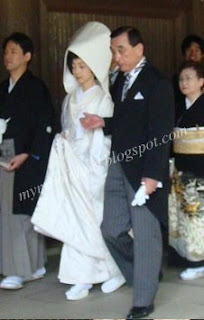From Sakae, we changed to Meijo line and reached the Jingu Nishi station. From the station we walked towards the Astuta Shrine. The busiest roads of the city looks so beautiful with the pink, rose and white flowered bushes on its both sides.
 |
| The roads of Jingu-Nishi. |
We have to walk a 10 minutes to reach infront one of the wooden gates of the Shrine .
 |
| The Shrine gate. |
The shrine was placed in a large wooded area that had city pretty much surrounding it on all sides.
 |
| The pavement inside the shrine. |
 |
| A bride seen in between the woods. |
We walked forward and reached a place with raised stone trough of cool water with wooden ladles laid upside down on a rack over the water. I have seen this earlier in Toganji temple at Nara. My husband who had went there with his Japanese friends earlier knew that it was for washing our feet and palms before entering the temple. There were nobody around us while we did it at Nara. We don't actually know the right procedure to use the laddle. There are a lot of people around the trough. We waited for sometime to watch what people are doing there. They take a ladle and pour water over their hands, one at a time, some would rinse out their mouths as well, then replace the ladle and dry their hands. It resembled our culture of washing feet and hands in temple ponds before entering inside.
About Atsuta shrine
Atsuta is the second among the venerable shrines of the country. It is devoted to Amaterasu, ( the Sun Goddess), and the Kusanagi no mitsurugi sword placed in the shrine is revered as one of the three Imperial regalia of the country.
Atsuta houses one of the three Imperial regalia of Japan given to the ruling family by Amaterasu – the sacred sword Ama-no-Murakumo-no-Tsurugi (“Sword of the Gathering Clouds of Heaven”), later renamed Kusanagi-no-Tsurugi (“Grasscutting Sword”) after its possessor, Yamato Takeru, used it to escape death in a burning field by cutting a space in the surrounding grass. The sword is said to control the winds, and Yamato used it to direct the winds to blow the fire back at the treacherous lord who had set the field afire. (The other two Imperial regalia are a mirror, housed at the Grand Shrine at Ise, and a jewel, housed at the Imperial Palace in Tokyo.)
Only a few highest priests are permitted to see the sword.The sword is believed to belong to the storm god Susanoo, and was passed on to the legendary hero Yamato-takeru who waved away the flames with his sword. Atsuta houses an enchanting collection of about four thousand artifacts that manifest the richness of ancient culture. Nearly seventy festivals are hosted here each year, and the shrine attracts numerous tourists to savor the richness of ancient traditions. One of the most popular festivals celebrated here is the Eyoudo ceremony in which the Shinto priests march around the shrine laughing and chanting.
We heard some musical instruments being played. There was some Japanese traditional danceform performed there along with musical instruments like drum, flute etc. There were four girls with a fan in one hand and some sort of stick in their other hand moving them in rhythm with the music. We watched it for sometime and walked towards the building where the great sword is kept.
 |
| In front of the shrine. |
We found a large structure with a fence in front of it. People were stand in front of the fence, bowing, throwing coins into a box on the other side of the fence and then clapped twice and again bowing. We observed them and did like that.
 |
| The building where the sword is kept. |
Once we stepped out of there, we saw a bride and groom walking towards the shrine. We stayed there watching them for a while and they started worshiping.
We went near the stage and once more watched the dance form , but now some more people have joined the girls on the stage with their flutes.
We walked towards the gate of the shrine and saw some other buildings there.
There as a temple at the left of the shrine gate. We just entered there, but e couldn't find much people here eventhough there were many inside the shrine. We left there in 5 minutes and walked towards the station.
 |
| Temple near the shrine gate. |














No comments:
Post a Comment